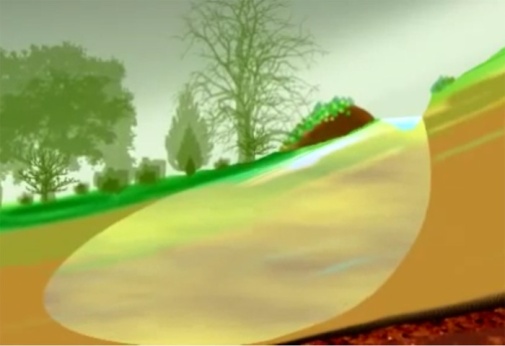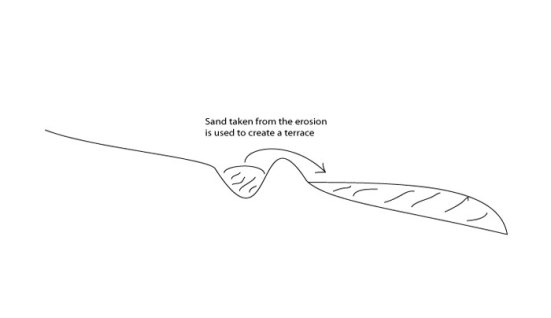A man built swale is a low tract of land following a contour line made to harvest rain runoff on a slope.
Here is a swale filled in by rain water run-off;
 |
View of profile ;
 |
Swales are the most convenient way to store water in presence of a slope.
When a land has been deforested no tree can prevent erosion any more. The water run-off remove in few years the top soil. The vegetation may then take decades or even centuries to settle again, constantly removed by new run-off and by the difficulty to settle roots in a hostile subsoil.
Swales, by creating a water channel help the process of water capture and infiltration in the soil. After only few years the vegetation settle again and the topsoil regenerate.
Swales are not eternal and erosion will still impact this earth-shaping architecture if no trees with deep roots are planted to take over with the erosion prevention. Various methods exist with regards to the location of the trees and the swale. Planting the tree on top of the bern of the swale allow quick root settlement since the soil is soft. However this location tends to dry rapidly so this needs to be done at start of the humid season. Planting the trees just below the swale allow to use the bern as a platform to access the swale and harvest the fruits of the trees.
A swale follows a contour line meaning that its construction needs to be done using adequate leveling tools. Two tools are mainly used;
– a “A” shape tool. In this case you need to tare it initially using a horizontal surface and mark the position of the vertical string on the horizontal bar of the “A”
– a transparent hose filled with water which is the most convenient tool if your swale is longer than 5 meters.
 |
In some cases you need first to remove the vegetation to access to the most probable point on the contour line. In order to avoid removing too much vegetation not being very sure where to go horizontally, the best way to assess this with your eyes alone is to locate yourself in a perpendicular position with regards to the contour line. Only in this position you may have a good guess of the horizontal plan. Trying to evaluate the horizontal position of a line looking in the same axes that the line infers mistakes.
The swale by capturing water will deeply modify the humidity and structure of the soil down the hill. A water lens or water plume is created which shape depends on the geological layer composition and the angle of the slope. Here is a description of the typical evolution of the water storage inside the ground.
 |
If you need to control and reduce the level of humidity generated down the swale the best way to do so is planting trees to monitor the water plume. This is a sensitive matter if you build a swale up the hill of a house. The humidity concentration could provoke water infiltration in the soil of the house.
Swale Overflow
Swales may include an overflow channel to redirect water to another swale or into the existing overflow network.
Water overflow channel needs to be covered using a non erodible material (e.g. plastic, … see picture below). Excavating the overflow channel without a protection from erosion will have the effect of the channel being dug up by the rain when overflow happens. The erosion will deepen the overflow channel until its bottom goes at the same level than the bottom of the swale, making the swale ineffective in holding the water.

The stones (as shown in the picture) ensure that the flow of water will not pass underneath the sheet to create erosion. The water level of the swale will be defined by the lowest border of the swale, in this case the channel protected by the sheet. To increase the swale water volume capacity the channel needs to be leveled up, taking care that it remains always the lower point of the pit borders.
Swales customization
In places with high erosion the swale will gather a lot of sand and sediments. This earth can be used either to be transferred in locations where soft soil is needed or even be used as sand for construction. A third solution is to use this earth to transform the shape of the swale in order to create a terrace. Sediments will help create a light and humid earth bed showing potential for growing crops.
The following section mainly the different types of swale you may create depending on the situation.
First of all it is important to differentiate a swale harvesting water run-off from a sandy sector or from a vegetation established situation.
The former will be filled over time by sand, silt and organic matter. As shown on the picture below.
 |
 |
The erosion has brought sand (seen in the middle of the photography) and silt (on the down/right side) which are being harvested and brought to another location where sandy soil will help root development.
In this context it is necessary to let the swale empty of vegetation or mulch in order to have easy access to the sand and silt and shovel the accumulated materials for different usage. In this case the swale plays an additional role which is harvesting certain textures of soil (sand and silt) which can be very useful, for example;
– to add sand in banana circles shape in a compacted soil. Or any earth-shaping requiring good drainage(e.g. Biodigestor evapo transpiration).
– to get sand, in certain cases pure enough, to use with cement.
– to get silt to mix with earth for additional fertility.
– to transform the swales into terraces by moving the sand down hill (see the photo below)
 |
A secondary swale (e.g. located down from the former) will not receive sand because the first swale make a barrier for the sand. In this case the swale can be filled in with mulch to better keep humidity and help reconstitute the top soil on the bottom of the swale or can be used as a German pit (HugelKultur in pits). In this case the vegetation settled there will need to be adapted to a swamp ecosystem with long periods of water logging depending on the rain water accumulation. (see photo below)
 |
The sand and silt accumulated from the upper swale can be mixed with the earth taken to make the terrace.
A swale always need to follow the contour line in order to keep the water in. However it may play as well a different role and have an additional specificity;
– Channeling water, to a pond for example, (see photo below)
– Have a depth variation in order to monitor the quantity of water infiltrating the soil. (see photo below)
 |
In case of channeling it may be necessary to add gates to monitor the overflow debit to the desired location. If let open the water flow will most of the time fill the pond and not stay at swale level. The priorities between pond level and water accumulation in the swale can be managed through simple gates. Once the water reach the top of the gate the overflow starts to fill the pond. The overflow of the pond can be avoided if necessary by having a water overflow evacuation point on the swale at the same level than the maximum desired pond water level.
Location of the plants on the swale system
Trees root system allow to fix the earth shape against erosion over time. It is then important to plant perennials, big enough to fix the swale. Over time the swale will disappear and the perennials will play the erosion control function (roots, mulch, humus, cover ground). If the slope is important deep tap root trees should be preferred.
Trees can be planted down the swale so that the mount can be used as a platform to access the fruits. In this case medium fruit trees can be planted (see photo below)
 |
If planted on the mount the fruit trees may be smaller to compensate the elevation (see photo below). The mount is usually soft since the earth has been dug up from the swale. The root system will develop easily there. The only drawback is the tendency of the mount to quickly become dry.
 |
It is unadvised to plant trees inside the pit since the soil is usually less fertile and very compacted. The bottom of the swale suffers as well important hydrometry variations which could impact the tree. To resolve this you may create a German pit as described above (only on secondary swales).
When defining the contour line before digging the swale it may happen that you encounter a tree on the way. It is then not necessary to remove the tree. You may dig the swale down or up the tree on the specific portion where it stands. By doing so you must make sure that the bottom of the swale and the top of the berm stay at the same level. When the slope is sharp the best alternative is digging the swale up the hill to skirt the tree. In both solutions a previous analysis of the tree root structure is necessary (size, resilience, age).
